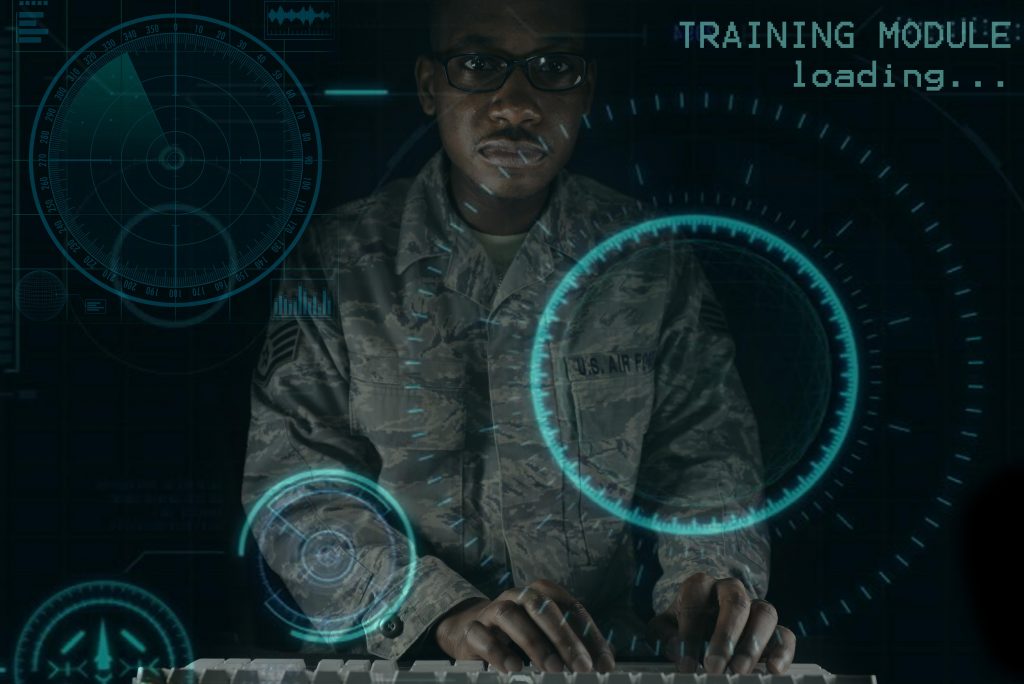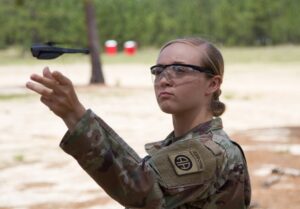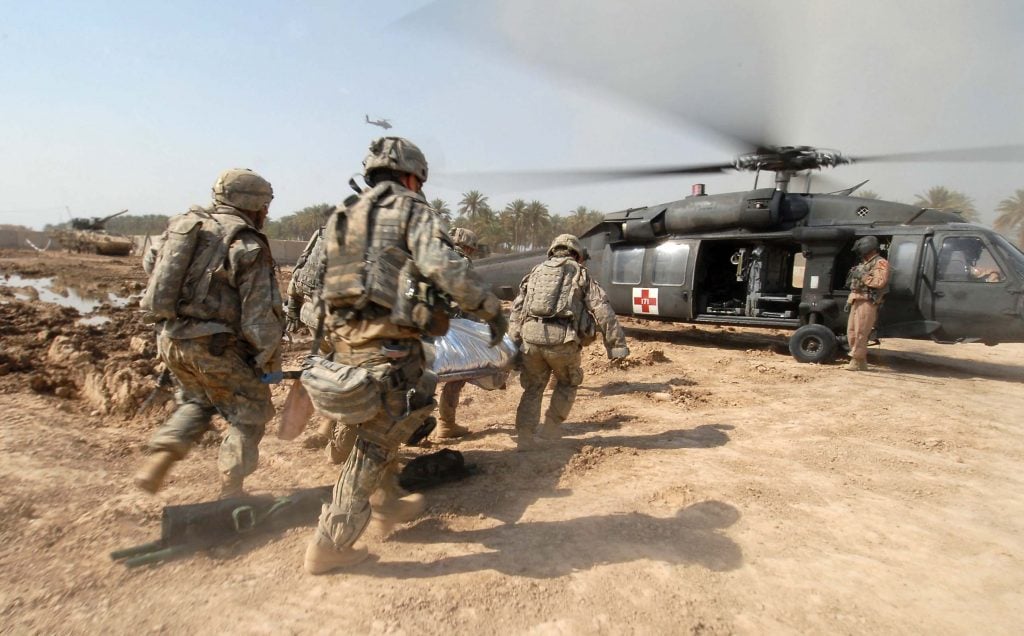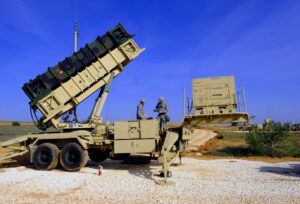By SYDNEY J. FREEDBERG JR.
 PENTAGON: The Joint Artificial Intelligence Center, barely a year old, has ambitious plans to expand its AI projects from helicopter maintenance and wildfire management to core functions of command and control, JAIC’s director said this morning. But Lt. Gen. Jack Shanahan cautioned that the early versions, like the Project Maven AI he led for two years, will be partial solutions that must evolve to earn commanders’ trust.
PENTAGON: The Joint Artificial Intelligence Center, barely a year old, has ambitious plans to expand its AI projects from helicopter maintenance and wildfire management to core functions of command and control, JAIC’s director said this morning. But Lt. Gen. Jack Shanahan cautioned that the early versions, like the Project Maven AI he led for two years, will be partial solutions that must evolve to earn commanders’ trust.
Last week, the chief of Air Combat Command, Gen. Mike Holmes, told reporters the Project Maven AI was still “learning… like your three-year-old.” Holmes isn’t yet ready to rely on the intelligence Maven provides through its algorithmic analysis of countless hours of surveillance video.
Lt. Gen. John “Jack” Shanahan
“General Holmes said exactly what I would have expected,” Shanahan told reporters at the Pentagon this morning. “He understands we fielded it as a prototype…. We knew, and the warfighters knew, they were getting a Minimum Viable Product. That’s the whole point of Agile Software Development.”
The initial iteration of Project Maven — Sprint-1, fielded in December 2017 — delivered “50 to 60 percent” of the ultimate goal, Shanahan said bluntly. After multiple monthly upgrades, the next major revision, Sprint-2, is being fielded “right now,” he said, with a Sprint-3 planned for 2020.
“It’s going to take a while to get that performance…but the warfighters are demanding those capabilities,” Shanahan said. “I was in a room no more than a week ago with a group of people from SOCOM and JSOC, who were … pounding the tables, saying, ‘Just give us the capabilities. We know it’s not perfect yet. We’re here to wring it out and tell you how to make it better.’ That has been a consistent theme from the special operatorssince the beginning of Project Maven.”
For a half century, DRS has provided military forces around the world with advanced technologies and capabilities to meet their mission needs. Here are some highlights.
Imperfect, in other words, can still be useful, and a 50 percent solution is still vastly better than nothing.
One way to get better AI products faster is the long-delayed JEDI cloud computing program. The Joint Enterprise Defense Infrastructure is intended to pool data from all over the Defense Department into a single, compatible corpus that will be invaluable raw material for machine learning algorithms.
“The problem with Maven is the lack of an enterprise cloud solution,” Shanahan said. “We weren’t getting enough data; the frequency of updates was not happening fast enough.”
But even once the cloud’s in place, JAIC plans to keep fielding imperfect solutions quickly — what Silicon Valley calls a “Minimum Viable Product” (MVP) — and then rapidly upgrading them based on feedback from real-world users. That field-feedback-fix-repeat cycle is central to the much-hyped private-sector best practices.
It’s also anathema to a highly bureaucratic acquisition process that wants to test everything exhaustively before real troops touch it. But the entire Defense Department has been struggling to streamline its system. Air Force acquisition chief Will Roper has called for a return to the Right Stuff era of the 1950s, when the service flew a new X-plane almost every year. This kind of high-speed trial-and-error works particularly well for software, which — unlike an experimental jet — generally doesn’t kill you when it crashes.
The Army wants a single seamless data system from home base to the front line. That’s even harder than it sounds.
The upgraded M109A7 Paladin fires during a test in Yuma, Arizona
AI For Maneuver & Fires
“Every piece of advice we ever got on starting an AI program at the department was ‘start small, prove it, build some expertise and credibility, and scale it from there,'” Shanahan said this morning. That’s why the JAIC got started with relatively low-key projects like cybersecurity; predictive maintenance, essentially analyzing early signs of helicopter engines under strain so mechanics can fix them before they fail; and disaster response, using Maven-style intelligence analysis to track wildfires and flooding.
It also helped JAIC’s soft-launch strategy that these early projects weren’t used for lethal missions, unlike Project Maven’s controversial target-spotting algorithms. Google, the original contractor on Maven, pulled out after an employee revolt. There’s also a Campaign to Stop Killer Robots that calls for an international treaty banning “lethal autonomous weapons systems.”
“There’s a tendency , a proclivity, to jump to a ‘killer robot’ discussion,” Shanahan said. “And yet, if you come and watch what my systems in Project Maven were doing, what we’re working in [now at JAIC], it’s as far from that … as you could possibly imagine.”
An 82nd Airborne soldier trains with a Black Hornet mini-drone before deploying to Afghanistan.
 JAIC will continue its non-violent applications of AI and add new ones, notably a predictive healthcare project to track military personnel for early warning signs of suicide. But the top priority for 2020, Shanahan said, will be “oriented on warfighting operations.
JAIC will continue its non-violent applications of AI and add new ones, notably a predictive healthcare project to track military personnel for early warning signs of suicide. But the top priority for 2020, Shanahan said, will be “oriented on warfighting operations.
“For fiscal year ’20, our biggest project will be what we are calling ‘AI for maneuver and fires,'” Shanahan said. Specific applications include “operations-intelligence fusion, joint all-domain command and control, accelerated sensor to shooter timelines, autonomous and swarming systems, target development, and operations center workflows.”
Now — with the possible, partial exception of swarms, if the drones and bots involved are actually armed and not just scouts or decoys — this still isn’t really “killer robots.” Instead of the Terminator, imagine a virtual staff officer.
Today’s commanders receive a constant flood of information, too much for the unaided human brain to manage. There are many different computerized systems to help make sense of it all — but precisely because those systems are many and different, each gives only a partial picture. Even when two separate command-and-control systems both provide information on the same subject, they may disagree. It’s up to commanders and their staffs to try to piece it all together — a process that often devolves to manually updated Excel spreadsheets and handwritten sticky notes.
Shanahan’s goal for 2020 is to start automating that process, training AI to collate all the disparate data into a single coherent picture so humans can spend their time deciding what to do about it. Building on the work of Project Maven, he explained, and working closely with the Joint Staff, JAIC will develop an AI that can combine intelligence, sensor data, and operational command-and-control information — such as where friendly units are right now — into a single Common Operational Picture (COP).
This kind of comprehensive understanding of the war zone — across the traditionally distinct warfighting domains of land, sea, air, space, and cyberspace — is essential for the kind of coordinated approach to combat that the Air Force and Army are calling “multi-domain operations.” (Shanahan prefers the term “all-domain”). One of JAIC’s principal partners, Shanahan said, is fellow Air Force three-star Bradford Shwedo, the Joint Staff’s point man to develop Multi-Domain Command and Control.

Soldiers rush a wounded civilian to a UH-60 medevac helicopter in Iraq.
Saving And Taking Lives
So what will all this mean for grunts? One tangible benefit should be much quicker fire support, with AI matching newly detected targets to the nearest suitable weapon much as Uber matches riders to drivers. By carefully cross-checking different data sources at machine speed, AI can also help reduce the errors that lead to friendly fire and dead civilians.
During Operation Desert Storm, Shanahan recounted, “somebody in a squadron I used to be in fired a high-speed anti-radiation missile, a HARM, off an F-4G [Wild Weasel]” at what they thought was an Iraqi anti-aircraft unit. The target turned out to be a US Army Patriot battery. “It hit and killed American soldiers. I am convinced,” he said, “that, had an artificial intelligence been around, that would not have happened.
Patriot anti-missile battery.
 “Humans are fallible. In combat, humans are particularly fallible and mistakes will happen,” Shanahan said. “AI can help mitigate the chances of those mistakes — not eliminate them… but maybe we have a lower instance of civilian casualties or collateral damage because we’re using artificial intelligence.”
“Humans are fallible. In combat, humans are particularly fallible and mistakes will happen,” Shanahan said. “AI can help mitigate the chances of those mistakes — not eliminate them… but maybe we have a lower instance of civilian casualties or collateral damage because we’re using artificial intelligence.”
To train that AI to see through the fog of war, however, you need a lot of data. To improve air and artillery support, he said, “the team just got access to tens of thousands of real world records from Iraq and Afghanistan on calls for fire.”
The aim of that project: “How do we get through the fire support coordination process much faster, much more efficiently?” he said. “If we’re having challenges with that in today’s fight, imagine what that time cycle looks like against a peer competitor, [where] I don’t have the luxury of hours or days to make decisions. It may be seconds and microseconds.
“What I don’t want to see is a future where our adversaries to have a fully AI-enabled force and we do not,” Shanahan said. While he avoids the term “arms race,” he said, “it is a strategic competition.”
So what’s the timeline to field these new AIs for commanders to use in the real world?
“It’s a little hard to say. We’re deep into the problem framing stage, because I didn’t have the funding for this in Fiscal Year 19,” Shanahan said. While Congress hasn’t yet approved JAIC’s $268 million request for FY 20, which begins Oct. 1, he said, “I am optimistic we’ll see progress in a couple of our different lines of effort in six months from October.”
“That’ll be a minimum viable product,” he said, “and then it’ll get better and better.”
No comments:
Post a Comment